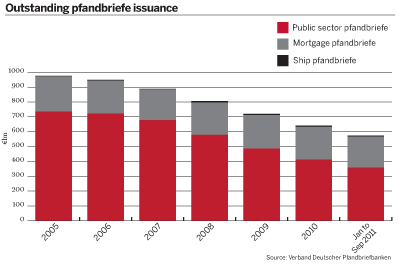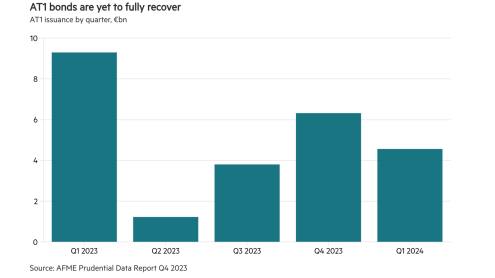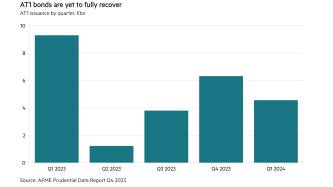In March 2009, Germany's Pfandbrief Act was amended to create a new class of pfandbrief backed by aircraft loan collateral. But putting together the first deal became a drawn-out process. Hanover-based NordLB has said that, market conditions permitting, it expects to offer €500m-worth of bonds during the first quarter of 2012. Another major aircraft lender, Frankfurt-based DVB Bank, is expected to follow shortly after with its own debt deal.
Both banks are among the top 10 global asset-based lenders in the aviation market, and pfandbriefe will constitute an important new source of refinancing for their aircraft loan books. The debut deals are expected to rely heavily upon domestic German bids, led by banks, insurance companies and funds. But the idea is to internationalise the product with subsequent dollar-based transactions, which may be of particular interest to US capital markets investors, as well as European accounts looking for some diversity in their covered bond holdings.
Dollar-based capital markets deals are currently of particular interest to aviation lenders. During mid-2011, the sudden withdrawal by US money market funds from investments in commercial paper issued by European banks had a severe impact on the major French aviation lenders. The German banks were less hard hit, but the market disruption has forced all lenders to look closer at mismatches between their funding and lending activities.
The new aircraft pfandbriefe are expected to be rated AA. The market is expected to develop in size to levels slightly below the long-established ship pfandbrief market, where deals are typically worth €2bn to €3bn each year.
Total pfandbriefe outstanding is likely to consolidate further to approximately E570bn by the end of 2012,
Specialised transport asset-based lender DVB Bank completed its first ever ship pfandbrief deal in December 2010. It sold €250m-worth of three-year bonds at 50 basis points over mid-swaps, in an offering led by DZ Bank (parent company of DVB) and Deutsche Bank. About 90% of the bonds were placed with investors in Germany, with the balance going to accounts in Austria and Luxembourg.
Supportive conditions
Given the volatility on financial markets, it is not an ideal time to be launching a new product. But aircraft pfandbriefe have an advantage in that there is currently a supply shortage of traditional mortgage pfandbriefe (backed by pools of commercial and residential real estate loans) and public sector pfandbriefe (backed, for example, by state-guaranteed loans or loans to municipalities).
German pfandbriefe continue to show a negative net supply, due to the abolition of state guarantees for landesbanken and savings banks in 2005, and the ongoing restructuring of numerous pfandbrief issuers. New issuance has declined steadily from €221bn in 2003 to about €80bn in 2011. According to a poll conducted by the German association of pfandbrief banks, Verband Deutscher Pfandbriefbanken (VDP), for its members, pfandbrief issuance is expected to reach €74bn in 2012, provided the sovereign crisis eases as the year progresses.
New pfandbrief issuance has been on a downward trend since 2008, mainly because many German banks have been reducing the size of their balance sheets
"Total pfandbriefe outstanding is likely to consolidate further to approximately €570bn by the end of 2012," says Christian Walburg, spokesperson at the VDP in Berlin. This compares with total outstandings of €1056bn at the end of 2003. "In 2012, mortgage pfandbrief issuance, including roughly €2bn in ship pfandbriefe, will maintain its strong position, with a forecast of €45bn of new issuance, while issuance of public sector pfandbrief will continue its consolidation, and is expected to total about €29bn," he adds.
Downward trend
According to Ted Lord, head of European covered bond origination at Barclays Capital in Frankfurt: "New pfandbrief issuance has been on a downward trend since 2008, mainly because many German banks have been reducing the size of their balance sheets, and given the shortage of supply of both mortgage and public sector pfandbriefe, spreads over bunds were at tight levels in 2011."
He adds that Asian central banks remain significant buyers, especially since the risk associated with sovereign bonds has become so hard to assess because of the eurozone crisis. And overall investor demand is likely to remain high, helped by Basel III guidelines, which say that commercial banks can hold up to 40% of their liquidity portfolios in covered bonds.
"Many banks in Germany, as is the case across Europe, are currently restructuring their businesses, and therefore we see a lack of supply, especially of public sector pfandbriefe," says Thomas Ludwig, director in Commerzbank's corporates and markets division in Frankfurt.
Mr Ludwig notes that the German pfandbriefe still trade at the tightest levels among the core covered bond countries. While spreads on covered bonds from the Netherlands, France and Austria widened in 2011, the German pfandbriefe has been very stable. He believes that the pfandbrief is likely to remain the most expensive covered bond product, supported by a lack of supply.
"We expect to continue to see buying from Asian central banks in 2012. They mainly buy benchmark-sized AAA rated pfandbriefe, and there is still an advantage for public sector pfandbriefe, since central bank investors are generally more familiar with public sector debt than the real estate market. But if we see a deterioration in the ratings of European sovereigns [nine eurozone countries were downgraded by Standard & Poor's in January], then all investors, including central bank buyers, will need to recalibrate their approach towards the ratings of bonds that they buy," says Mr Ludwig.
Premium product
During the boom years of 2006 and 2007, covered bonds from other jurisdictions were getting close to pfandbrief on pricing, challenging its primacy. But two factors have combined to keep the pfandbrief-issuing banks in a strong position.
First is the scarcity of new issues, at a time when the vast German investor base has been looking for safe investments. Second, covered bonds trade close to the sovereign, and the flight to quality in the 2011 crisis environment made German bunds one of the most favoured safe havens globally, even for conservative buyers such as Asian central banks.
For example, in May 2011 BayernLB closed an offering of €1.25bn of three-and-a-half-year public sector pfandbriefe, led by Credit Suisse, NordLB, Société Générale and UniCredit. The bonds priced at mid-swaps plus just six basis points. German investors bought 61% of the deal, with Switzerland and Austria taking 18%. But there was also very strong demand from Asia, with accounts there taking 8%.
No global domination
The pfandbrief no longer dominates global covered bond supply, as was the case five years ago, when German issuers made up 75% of global issuance. That figure is now more like 25%, but the pfandbrief has re-asserted itself as the premium product with the tightest spread.
"Euro benchmark covered bond issuance by non-eurozone issuers was at a historical high in 2011, at about €47bn, and we expect non-eurozone issuers to continue to heavily tap the euro benchmark covered bond market in 2012," says Bernd Volk, strategist at Deutsche Bank in Zurich. Benchmarks are typically defined as being publicly offered with a volume of at least €500m.
"Spread heterogeneity between different countries is currently at historical highs and is likely to remain elevated. If eurozone sovereign spreads reconverge, we expect covered bond spreads to follow, but to converge less," says Mr Volk.
As of early January, the yield curve for public sector pfandbriefe was pricing at 2.049% for five-year and 2.802% for 10-year pfandbriefe. For mortgage pfandbriefe, yields were 2.126% for five-year and 2.877% for 10-year bonds.
Tight pricing has been helped by the scarcity factor, and for the German banks, access to the deep pfandbrief market has been a big advantage all through the financial crisis, which began with the collapse of Lehman Brothers in September 2008. Germany has a very strong domestic bid, which is a clear advantage in an uncertain environment where investors are taking a safety first approach.
Credit downgrade
The pfandbrief market has traditionally been heavily dominated by AAA issuance, but since the 2008 financial crisis there have been a number of downgrades associated with the creditworthiness of issuers. Covered bonds are full recourse to the issuer, with the collateral serving as back-up in case of bankruptcy.
In December 2011, Fitch Ratings downgraded Eurohypo's public sector pfandbrief to AA from AAA, while at the same time affirming the mortgage pfandbrief at AAA. Both ratings were then withdrawn, with Fitch saying that the issuer had chosen to stop participating in the process, and that it would no longer have enough information to maintain a rating.
But most pfandbriefe are currently enjoying a stable outlook. Fitch currently has 21% of all covered bonds on 'rating watch negative', with the majority of these based in peripheral Europe.
"Versus peripheral Europe, covered bond ratings in other regions have significantly more cushion before a bank issuer default rating downgrade would cause a covered bond downgrade," says Suzanne Albers, senior director at Fitch in London.
Within the eurozone, but outside peripheral Europe, Fitch rates programmes in Germany, France, Luxembourg and the Netherlands, which have AAA/stable sovereign ratings, with the exception of France, which is rated AAA/negative.
"Until the eurozone crisis is fully resolved, these countries could be impacted, but the agency does not expect the covered bonds issued out of these jurisdictions to be critically exposed to worsening cover pool asset liquidity," says Ms Albers.












